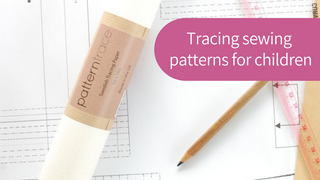One thing you can rely on is that children are always growing! There are so many brilliant childrens patterns on the market and most of them cover a very large size range making them excellent value. We were gifted a copy of Two Stitches Charlie Hoodie so we could show you how to really make the most of sewing for the small people in your life!
First things first, this is a beautifully presented pattern, the stitching on the spine especially is just perfect!


I’m making the hoodie for my nephew who’s about to turn 1, so I’m making the 12-18m size, but the pattern covers 6m to 9 years which if you’re clever is an awful lot of hoodies for the price of a pattern!
The key here is not to cut into the pattern sheet, I know you want to, and I know it’s marginally quicker that way, but believe me, in the long run you’ll be thanking me!
The Charlie Hoodie pattern fits on to one huge sheet of paper, I had to spread it out on the kitchen floor,

We’re going to trace off the size that we’re making, in my case 12-18m, I used an ordinary biro but a pencil would work just as well (don’t use a felt pen/sharpie if you don’t want to leave marks on the original pattern sheet). Roll out your roll of Patterntrace over the pattern sheet, the roll is 1m wide and is perfect for this sort of large scale tracing, no need to tape pieces together!

I’ve used some paper weights to hold it in place, but anything heavy will do, patternweights or tins of beans…! Make yourself comfy (I know, it’s the kitchen floor..) and begin to trace. Make sure you label your patternpieces with:
- the grainline
- how many to cut
- the fold line if appropriate
- the pattern piece name/number or letter
- and IMPORTANTLY which size it is!
Once you’ve finished tracing, take your Patterntrace to a comfier spot and cut out your paper pattern pieces followed by your fabric.

Add in a bit of sewing magic and very soon I was the proud owner of this little number!




I’m so pleased with the result, I hope the small recipient will be too! I feel sure that I’ll be making another one of two of these in the future. I’ve packed the 12-18m pattern pieces away with the intact original pattern in one of our Pattern Storage Envelopes so I’m ready and able to make one up every year for the next 8 years 😀

Nestled in its home on the shelf with my other patterns, the diamond washi tape denotes children’s patterns. Have you made any good children’s clothes? I’m all ears for good recommendations!

